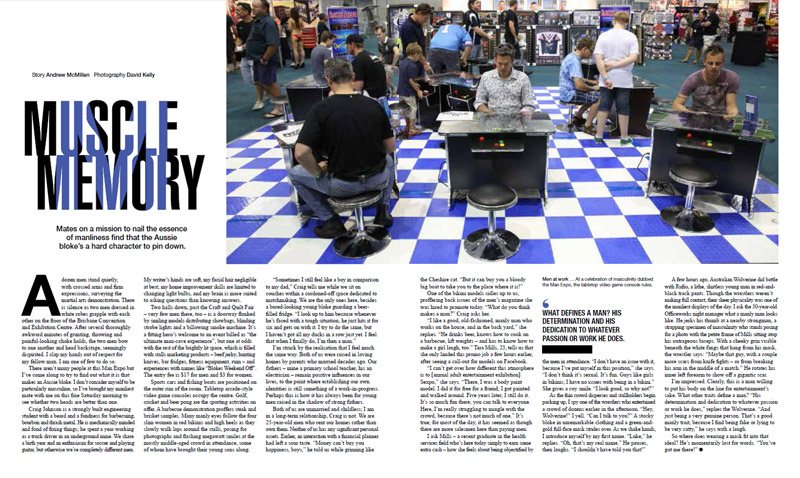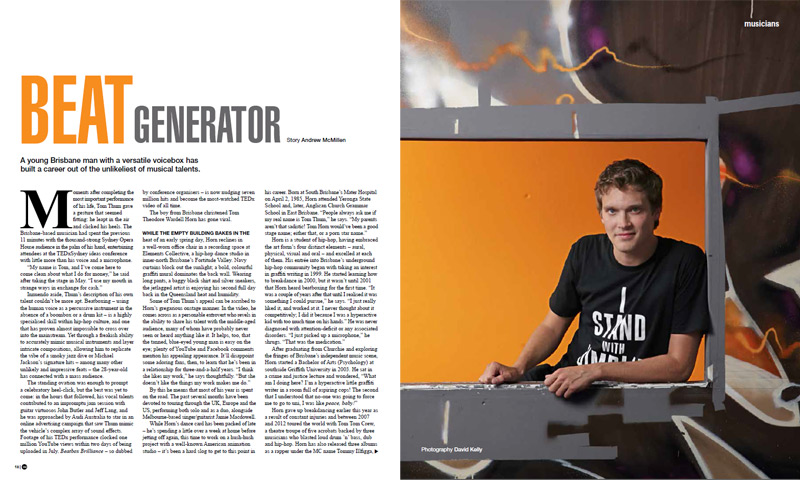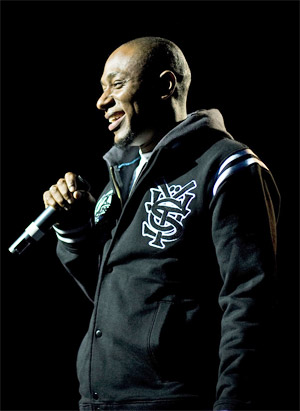Qweekend story: ‘Muscle Memory’, December 2013
A story for the final issue of Qweekend for 2013. Click the below image to view the PDF, or read the story text underneath.
Muscle Memory
Mates on a mission to nail the essence of manliness find that the Aussie bloke’s a hard character to pin down.
Story: Andrew McMillen / Photography: David Kelly
A dozen men stand quietly, with crossed arms and firm expressions, surveying the martial arts demonstration. There is silence as two men dressed in white robes grapple with each other on the floor of the Brisbane Convention and Exhibition Centre. After several thoroughly awkward minutes of grunting, throwing and painful-looking choke holds, the two men bow to one another and head backstage, seemingly dispirited. I clap my hands out of respect for my fellow man. I am one of few to do so.
There aren’t many people at this Man Expo but I’ve come along to try to find out what it is that makes an Aussie bloke. I don’t consider myself to be particularly masculine, so I’ve brought my manliest mate with me on this fine Saturday morning in mid-October to see whether two heads are better than one.
Craig Johnson is a strongly-built engineering student with a beard and a fondness for barbecuing, bourbon and thrash metal. He is mechanically minded and fond of fixing things; he spent a year working as a truck driver in an underground mine. We share a birth year and an enthusiasm for soccer and playing guitar, but otherwise we’re completely different men. My writer’s hands are soft, my facial hair negligible at best; my home improvement skills are limited to changing lightbulbs, and my brain is more suited to asking questions than knowing answers.
Two halls down, past the Craft & Quilt Fair – very few men there, too – is a doorway flanked by smiling models distributing showbags, blinding strobe lights and a billowing smoke machine. It’s a fitting hero’s welcome to an event billed as “the ultimate man-cave experience”, but one at odds with the rest of the brightly lit space, which is filled with stalls marketing products – beef jerky, hunting knives, bar fridges, fitness equipment, rum – and experiences with names like “Blokes Weekend Off”. The entry fee is $17 for men and $3 for women.
Sports cars and fishing boats are positioned on the outer rim of the room. Tabletop arcade-style video game consoles occupy the centre. Golf, cricket and beer pong are the sporting activities on offer. A barbecue demonstration proffers steak and brisket samples. Many manly eyes follow the four slim women in red bikinis and high heels as they slowly walk laps around the stalls, posing for photographs and flashing megawatt smiles at the mostly middle-aged crowd in attendance, some of whom have brought their young sons along.
“Sometimes I still feel like a boy in comparison to my Dad,” Craig tells me while we sit on couches within a cordoned-off space dedicated to matchmaking. We are the only ones here, besides a bored-looking young bloke guarding a beer-filled fridge. “I look up to him because whenever he’s faced with a tough situation, he just hits a six and gets on with it. I try to do the same, but I haven’t got all my ducks in a row just yet. I feel that when I finally do, I’m then a man.”
I’m struck by the realisation that I feel much the same way. Both of us were raised in loving homes by parents who married decades ago. Our fathers – mine a primary school teacher, his an electrician – remain positive influences in our lives, to the point where establishing our own identities is still something of a work-in-progress. Perhaps this is how it has always been for young men raised in the shadow of strong fathers.
Both of us are unmarried and childless; I am in a long-term relationship, Craig is not. We are 25 year-old men who rent our homes rather than owning them. Neither of us has any significant personal assets. Earlier, an interaction with a financial planner had left a sour taste. “Money can’t buy you happiness, boys,” he told us while grinning like the Cheshire cat. “But it can buy you a bloody big boat to take you to the place where it is!”
One of the bikini models sidles up to us, proffering back issues of the men’s magazine she was hired to promote today. “What do you think makes a man?” Craig asks her.
“I like a good, old fashioned, manly man who works on the house, and in the backyard,” she replies. “He drinks beer, knows how to cook on a barbecue, lift weights – and has to know how to make a girl laugh, too.” Tara Mills, 23, tells us that she only landed this promo job a few hours earlier, after seeing a call-out for models on Facebook.
“I can’t get over how different this atmosphere is to [annual adult entertainment exhibition] Sexpo,” she says. “I was a body paint model. I did it for free for a friend; I got painted and walked around. Five years later, I still do it. It’s so much fun there; you can talk to everyone. Here, I’m really struggling to mingle with the crowd, because there’s not much of one.” It’s true; for most of the day, it has seemed as though there are more salesmen here than paying men.
I ask Mills – a recent graduate in the health services field, who is here today simply to earn some extra cash – how she feels about being objectified by the men in attendance. “I don’t have an issue with it, because I’ve put myself in this position,” she says. “I don’t think it’s sexual. It’s fun. Guys like girls in bikinis; I have no issues with being in a bikini.” She gives a coy smile. “I look good, so why not?”
As the thin crowd of men disperses and stallholders begin packing up, I spy one of the wrestlers who entertained a crowd of dozens earlier in the afternoon. “Hey, Wolverine!” I yell. “Can I talk to you?” A stocky bloke in unremarkable clothing and a green-and-gold full-face mask strides over. As we shake hands, I introduce myself by my first name. “Luke,” he replies. “Oh, that’s my real name.” He pauses, then laughs. “I shouldn’t have told you that!”
A few hours ago, Australian Wolverine did battle with Rufio, a lithe, shirtless young man in red-and-black trackpants. Though the wrestlers weren’t making full contact, their sheer physicality was among the manliest displays of the day. I ask the 30 year-old OfficeWorks night manager what a manly man looks like. He jerks his thumb at a nearby strongman, a strapping specimen of masculinity who stands posing for a photo with the petite frame of Mills sitting atop his outrageous biceps. With a cheeky grin visible beneath the white fangs that hang from his mask, the wrestler says, “Maybe that guy, with a couple more scars from knife fights – or from breaking his arm in the middle of a match.” He rotates his inner left forearm to show off a gigantic scar.
I’m impressed. Clearly, this is a man willing to put his body on the line for entertainment’s sake. What other traits define a man? “His determination and dedication to whatever passion or work he does,” replies the Wolverine. “And just being a very genuine person, too. I find that’s a good manly trait, because I find being fake or lying to be very catty,” he says with a laugh.
So where does wearing a mask fit into that ideal? He’s momentarily lost for words. “You’ve got me there!”


 One Saturday morning last November, Horn woke with a start in his rented Berlin apartment. His musical offsider, Jamie Macdowell, was about to leave to get a second key cut. The pair had performed together the previous night and come home, completely sober; a strangely quiet Friday for two young men in a foreign country. Suddenly, Horn broke the silence by yelling for his friend. “I went into his bedroom and Tom was reeling,” says Macdowell, 27. “He said it felt like there was a ten cent piece on his sternum, and an elephant was sitting on the coin. As soon as he sat up, he just lost his mind. The pain got so intense that he couldn’t talk or move. He fell back down onto the bed and was shaking. It looked like he couldn’t breathe.”
One Saturday morning last November, Horn woke with a start in his rented Berlin apartment. His musical offsider, Jamie Macdowell, was about to leave to get a second key cut. The pair had performed together the previous night and come home, completely sober; a strangely quiet Friday for two young men in a foreign country. Suddenly, Horn broke the silence by yelling for his friend. “I went into his bedroom and Tom was reeling,” says Macdowell, 27. “He said it felt like there was a ten cent piece on his sternum, and an elephant was sitting on the coin. As soon as he sat up, he just lost his mind. The pain got so intense that he couldn’t talk or move. He fell back down onto the bed and was shaking. It looked like he couldn’t breathe.” One year ago, acclaimed American hip-hop artist Dante Smith – stage name Mos Def (pictured right) – was set to tour Australia for the first time. Eleven shows were booked, including headline festival appearances at Soundscape in Hobart and The Hot Barbeque in Melbourne. After failing to appear at his first scheduled performance in Adelaide, he went on to randomly skip four shows of the itinerary. Such was the ensuing confusion, that following the postponements, cancellations and sternly-worded press releases from the promoter, Peace Music, became something of a sport here at TheVine. For background, revisit our news story
One year ago, acclaimed American hip-hop artist Dante Smith – stage name Mos Def (pictured right) – was set to tour Australia for the first time. Eleven shows were booked, including headline festival appearances at Soundscape in Hobart and The Hot Barbeque in Melbourne. After failing to appear at his first scheduled performance in Adelaide, he went on to randomly skip four shows of the itinerary. Such was the ensuing confusion, that following the postponements, cancellations and sternly-worded press releases from the promoter, Peace Music, became something of a sport here at TheVine. For background, revisit our news story